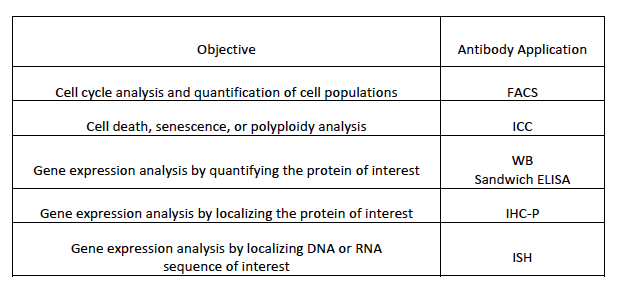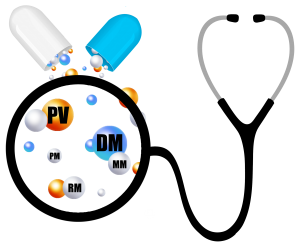Choosing the Right Immunoassays for Your Radiobiology Experiments

Radiation therapy is one of the most common treatments for cancer. In order to improve the treatment efficacy of radiation therapies, radiobiology is the field of basic research that studies the cellular and molecular biological factors influencing the response of cancerous and normal cell lines to ionizing radiation. In a typical radiobiology experiment, a cell culture is exposed to a known dose of ionizing radiation to induce alterations in cell growth pattern, alterations in cell surface, alterations in intracellular components and biochemical processes, and/or tumorigenesis.
What are the Antibody Applications used in radiobiology experiments?
A wide array of antibody-based techniques is used in radiobiology experiments. This includes western blot (WB), immunoassays as sandwich enzyme-linked immunosorbent assay (ELISA), flow cytometry as fluorescence-activated cell sorting (FACS), and immunofluorescence as immunocytochemistry (ICC), paraffin-embedded immunohistochemistry (IHC-P), or in situ hybridization (ISH).
How to choose the right “Antibody Application” for your radiobiology experiment?
Choosing the right “Antibody Application” for your radiobiology experiment can be challenging. The selection process depends on your objective.
Cell Cycle Analysis:
If your objective is cell cycle analysis and quantification of cell populations after inducing alterations in cell growth pattern, then FACS would be the suitable application.
Advantages of FACS:
- Good signal: noise ratio.
- High degree of accuracy and sensitivity.
Limitations of FACS:
- Suspended cells only. The cell suspension is blocked with IVIG blocking reagent to avoid non-specific antibody uptake, incubated with fluorescently-tagged monoclonal antibodies that recognize specific surface markers for surface staining, fixed, suspended in culture medium, and passed as a narrow stream of cells surrounded by fluid of the same refractive index in front of a laser. For intracellular staining, the cells must be permeabilized 1st before incubation with the antibodies.
- Viability of suspended cells must be good to avoid false positive results. Dead cells are permeable and take up antibodies non-specifically.
Bench tips on FACS:
- Use a dead cell marker to distinguish dead cells and remove their fluorescence intensity readings from data analysis.
- Achieve optimal resolution by concentrating your sample and running it slow to keep a narrow stream of suspended cells.
- Work in the dark!!
Cell Death, Senescence, or Polyploidy Analysis:
If your objective is cell death, senescence, or polyploidy analysis after inducing alterations in cell growth pattern, then ICC would be the appropriate application.
Advantages of ICC:
- Good signal: noise ratio.
- High degree of accuracy and sensitivity.
Limitations of ICC:
- Quenching or transfer of energy of the excited fluorophore molecule while in the singlet state to a nearby molecule leading to positive staining of the 2ry control antibody.
- Photobleaching or oxidation of the fluorophore molecule resulting in structural change with loss of ability to generate emission photons with time. This is disadvantageous with fluorescence live cell imaging and time-lapse microscopy.
Bench tips on ICC:
- DAPI is the ICC fluorescent stain of choice for radiobiology experiments. Compared to other ICC fluorescent stains, DAPI is more photo-stable, less hazardous (stains dead fixed permeabilized cells only), labeled as non-toxic in its’ MSDS, more convenient to use (most microscopes have a specific DAPI channel), diffuses better through cells and tissues, has a good shelf life, and is relatively inexpensive.
- Add Shape 0.1M Tris or Glycine buffer to formaldehyde to avoid fixative induced auto-fluorescence.
Gene Expression Analysis via Quantification of the Protein of Interest in the Lysate of the Cell Culture:
If your objective is gene expression analysis by quantifying the protein of interest after inducing alterations in intracellular components and biochemical processes, and the protein of interest is expressed in the lysate of the cell culture, then WB is the most commonly used method.
Advantages of WB:
- High degree of accuracy, sensitivity, and specificity.
Limitations of WB:
- Cell Lysate only.
- High technical demand. WB is a multistep delicate process that requires high degree of precision and accuracy. The slightest error in a reagent concentration for example can easily fail your experiment.
Bench tips on WB:
- The cell culture dish must be placed on ice in an ice-filled styrofoam box while aspirating the culture medium and washing the dish with ice cold phosphate buffered saline (PBS).
- Molecular weight of the protein of interest determines the recipe of the resolving gel.
- When preparing the resolving gel, at the end of your preparation sequence and after adding the APS 10%, shake, add TEMED, then re-shake again to ensure proper mixing.
- Loading the cell lysate sample with the loading buffer requires boiling at 95 oC for 5 minutes to denature the tertiary structure of the protein of interest.
- Rinse the micro syringe with the running buffer each time before injecting a new cell lysate sample into its’ corresponding well to avoid cross contamination.
- Include a positive and a negative control on the gel along with the cell lysate samples.
- Activate the Polyvinylidene Difluoride (PVDF) transfer / blotting membrane by soaking it in methanol for 1-2 minutes then incubate in ice cold transfer buffer for 5 minutes.
- The vertical electrophoresis apparatus must be placed in an ice-filled container on a magnetic stirrer with a magnetic stirring bar inside the apparatus.
- Orientation of the stack containing the gel-membrane sandwich within the cassette is vital and essential for a successful transfer.
- Detection method makes a big difference. There are 3 detection methods: colorimetric, chemiluminescence, and fluorescence. Choose your detection method wisely:
- Colorimetric detection method is less costly yet the least sensitive compared to the other methods. It uses the alkaline phosphatase enzyme and a chromogenic substrate.
- Chemiluminescence detection method is preferred if a single protein is targeted for detection. The signal detected may not be proportional to the amount of target protein blotted on the transfer membrane. It uses the horseradish peroxidase enzyme and a luminescent substrate.
- Fluorescence detection method is a highly sensitive and specific detection method compared to the other methods. It can target several different proteins simultaneously without stripping and re-probing. The signal detected is reliably proportional to the amount of target proteins blotted on the transfer membrane.
Gene Expression Analysis via Quantification of the Protein of Interest in the Supernatant of the Cell Culture:
However, if your objective is gene expression analysis by quantifying the protein of interest after inducing alterations in intracellular components and biochemical processes, and the protein of interest is expressed in the supernatant of the cell culture, then you might consider sandwich ELISA as a suitable substitute.
Advantages of Sandwich ELISA:
- High specificity.
- Less background and increased signal: noise ratio.
Limitations of Sandwich ELISA:
- Slow speed of processing.
- Requires more incubations and washes.
Bench tips on Sandwich ELISA:
- Activate your protein of interest.
- Plan your 96-well plate layout.
- After streptavidin-horse radish peroxidase, cover the plate to avoid light exposure.
- Setup the bichromatic absorbance of the microplate reader at 450/620 nm. The 620 nm is considered the reference wavelength. The mean absorbance values of all triplicate wells measured at 450 nm are subtracted from their counterpart mean absorbance values of all triplicate wells measured at the reference wavelength to obtain accurate and reliable results.
Gene Expression Analysis via Localization of the Protein of Interest:
If your objective is gene expression analysis by localizing the protein of interest after inducing alterations in intracellular components and biochemical processes, then IHC-P (paraffin-embedded) is the perfect match.
Advantages of IHC-P:
- High sensitivity.
Limitations of IHC-P:
- Co-localization. Using different chromagens in detection of multiple labelled antigen-antibody reactions leads to overlapping colors and hence difficult target localization.
Bench tips on IHC-P:
- Formaldehyde is the fixative of choice.
- Antigen retrieval time should be at least 3 minutes.
- Allow the slides enough time to cool down for epitope reformation.
Gene Expression Analysis via Localization of DNA or RNA Sequence of Interest :
Lastly, ISH provides a good alternative if your objective is gene expression analysis by localizing a specific DNA or RNA sequence in a tissue section.
Advantages of ISH:
- High sensitivity and specificity.
- Less background and increased signal: noise ratio.
Limitations of ISH:
- Designing the probes can be challenging . If more than 5% of the probes’ base pairs aren’t complementary to their target mRNA or DNA nucleotide sequence, there will be a high chance of loose hybridization thus decreasing the sensitivity of ISH.
- Non-specific labeling.
Bench tips on ISH:
- Optimize hybridization temperature to be in the range of 55-62°C. This optimal temperature range breaks hydrogen bonds allowing proper denaturation of DNA.
- Use RNase free reagents. RNase destroys cellular RNA causing nonspecific binding of probe to tissue components and leading to false positive results.
- Detection method makes a big difference. There are 3 detection methods: radioactive, chromogenic, and fluorescence. Choose your detection method wisely:
- Radioactive detection method is less costly yet less sensitive compared to the other methods of detection. It requires the use of radiolabeled ligands which makes this method hazardous to health and needs a lengthy exposure time for autoradiography.
- Chromogenic method is preferred if a single DNA or RNA sequence is targeted. The signal and tissue morphology can be viewed simultaneously.
- Fluorescence detection method is a highly sensitive and specific detection method compared to the other methods. It can target several different DNA or RNA sequences simultaneously. It has many clinical applications and is used as a prognostic biomarker for malignancies and predictive biomarker for response to therapy e.g. detection of HER2 gene amplification.
To wrap it up, the choice of the right “Antibody Application” for your radiobiology experiment depends on its’ objective. Each ‘Antibody Application” has its’ advantages and limitations. “Antibody Applications” bench tips are useful for trouble shouting and problem solving.


Your suggestions on how to improve and develop our medical writing service are welcomed. Please take a moment and provide your valuable feedback. Thank you!
May I simply just say what a relief to uncover someone who really knows what they are talking about over the internet. You certainly know how to bring a problem to light and make it important. More and more people have to check this out and understand this side of the story. It’s surprising you aren’t more popular given that you surely possess the gift.
I have been browsing online greater than three hours these days, yet I by no means discovered any interesting article like yours. It抯 beautiful worth sufficient for me. In my opinion, if all website owners and bloggers made just right content as you probably did, the web will be much more helpful than ever before.
Thank you for your feedback! Your feedback inspires us and drives our passion for connecting with our stakeholders.
At MD Pharma Consulting Group we care a lot for the quality of our blogs and scientific articles. We try to keep it short, simple, and to the point.
Thank you for your feedback! Your feedback inspires us and drives our passion for connecting with our stakeholders.
Hello! Would you mind if I share your blog with my facebook group? There’s a lot of people that I think would really appreciate your content. Please let me know. Thanks
For sure you can. Thank you!